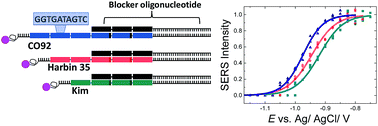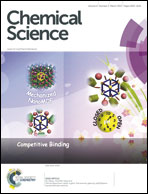Strain discrimination of Yersinia pestis using a SERS-based electrochemically driven melting curve analysis of variable number tandem repeat sequences†
Abstract
Strain discrimination within genetically highly similar bacteria is critical for epidemiological studies and forensic applications. An electrochemically driven melting curve analysis monitored by SERS has been utilised to reliably discriminate strains of the bacterial pathogen Yersinia pestis, the causative agent of plague. DNA amplicons containing Variable Number Tandem Repeats (VNTRs) were generated from three strains of Y. pestis: CO92, Harbin 35 and Kim. These amplicons contained a 10 base pair VNTR repeated 6, 5, and 4 times in CO92, Harbin 35 and Kim respectively. The assay also included a blocker oligonucleotide comprising 3 repeats of the 10-mer VNTR sequence. The use of the blocker reduced the effective length of the target sequence available to bind to the surface bound probe and significantly improved the sensitivity of the discrimination. The results were consistent during three replicates that were carried out on different days, using different batches of PCR product and different SERS sphere segment void (SSV) substrate. This methodology which combines low cost, speed and sensitivity is a promising alternative to the time consuming current electrophoretic methods.


 Please wait while we load your content...
Please wait while we load your content...